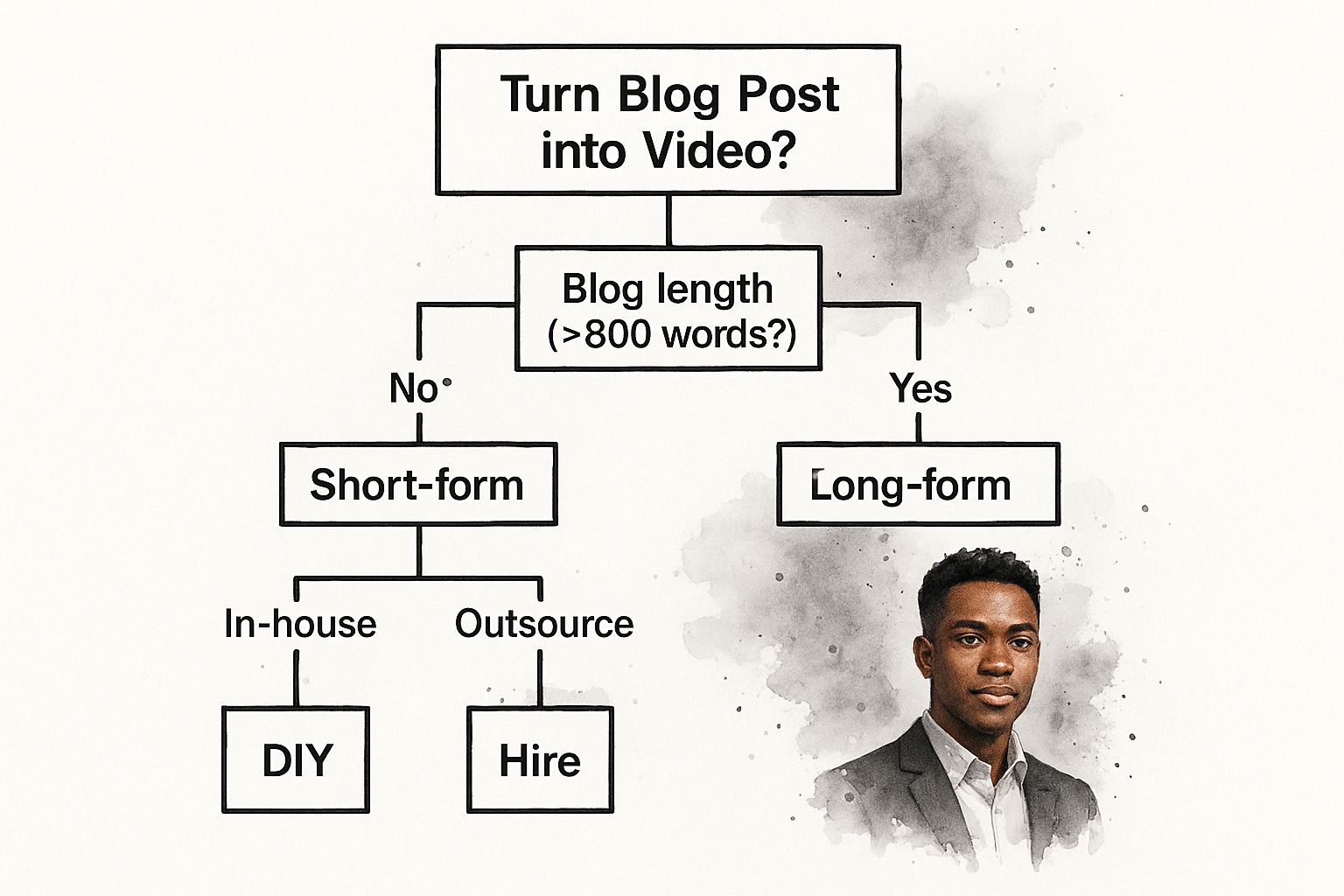Why Blog-to-Video Transformation Drives Real Results

The content world is constantly changing, and video is now front and center. Smart brands are seeing the value in repurposing their written content, transforming well-performing blog posts into engaging videos. This isn't just about following the latest trend; it's about forging deeper connections with audiences. But what makes this blog-to-video shift so effective?
Reaching a Wider Audience Through Diverse Learning Styles
A primary advantage is the ability to connect with different learning styles. Some people learn best by reading, while others thrive with visual and auditory content. Transforming a blog post into a video offers the same valuable information in a format that clicks with a broader audience. This unlocks new opportunities, expanding your reach and maximizing your content's effect.
Extending Content Lifespan and Boosting Engagement
Repurposing blog content into video significantly extends its lifespan. A blog post might have a limited peak performance window, but a video can continue attracting views and engagement for months or even years. This is especially true on platforms like YouTube, which act as powerful search engines. This improves visibility and discoverability, resulting in a higher return on investment (ROI) for your content creation. For example, embedding a video in your blog post can considerably increase engagement and time spent on the page, reducing bounce rates and encouraging exploration of more of your content.
Let's take a look at the engagement differences between blog posts and videos:
To illustrate these differences, let's examine a comparison table showcasing key performance metrics.
Blog Posts vs. Videos: Engagement Comparison
| Metric | Blog Posts | Videos | Percentage Difference |
|---|---|---|---|
| Average Time on Page | 2 minutes | 5 minutes | +150% |
| Bounce Rate | 60% | 40% | -33% |
| Social Shares | 50 | 150 | +200% |
| Conversion Rate | 2% | 4% | +100% |
This table demonstrates how video content generally outperforms blog posts in key engagement metrics. Videos tend to hold viewers' attention longer, resulting in lower bounce rates and increased social sharing. The higher conversion rates associated with video content highlight its potential to drive tangible business outcomes.
Driving Measurable Business Results
Ultimately, the blog-to-video transformation delivers measurable results. Greater engagement often translates to improved conversion rates. Whether you're aiming to generate leads, boost sales, or simply build brand awareness, converting blog posts to videos can significantly contribute to your objectives. Video's visual nature amplifies your message, making it more compelling and memorable for viewers. In fact, adding video to a landing page can boost conversions by a remarkable 86% compared to text-only pages. Marketers repurposing blog content into video frequently report improved ROI and increased sales. A striking 84% of video marketers state that video has directly boosted sales. This substantial increase demonstrates video content's persuasive power. Find more detailed statistics here This means investing in video content can be a highly effective strategy for improving your bottom line.
Identifying Your High-Potential Blog Content for Video
Not every blog post is a natural fit for video. Some topics shine in written form, while others are practically begging for visual storytelling. This section helps you pinpoint the blog posts ripe for video adaptation by evaluating their visual potential, emotional impact, and complexity. We’ll also explore how using analytics can reveal hidden engagement gems and help you build a strategic content pipeline focused on high-conversion, high-ROI videos.
Evaluating Content For Visual Appeal and Emotional Impact
Start by considering the visual potential of your blog post. Ask yourself: Does the content include data that can be brought to life with charts and graphs? Does the topic lend itself to visual demonstrations or storytelling? A blog post about baking a cake, for example, easily translates to video, showcasing each step visually. On the other hand, a highly technical coding tutorial might be tougher to visualize effectively.
The emotional resonance of your content is equally important. Does it evoke strong emotions, tell a compelling story, or offer practical advice viewers can connect with? Emotionally driven content tends to perform well on video platforms, as it encourages viewers to share and engage.
For further guidance on converting blog posts to videos, check out this helpful resource: How to Master the Art of Blog-to-Video Conversion. Many creators are seeing the value in this approach, and you can too: Turn Blog Post Into Video.
Analyzing Analytics For Hidden Engagement Patterns
Your blog post analytics hold valuable clues. Look for posts with high traffic, long dwell times, and substantial social shares. These metrics indicate audience interest and suggest a topic's potential for video success. Numbers aren’t everything, though. Consider qualitative factors like comments and reader feedback to truly understand what resonates with your audience. This means combining data-driven insights with an understanding of audience preferences.
Building A Strategic Content Pipeline
Prioritizing blog posts with the highest video potential helps you use your resources effectively. Create a content scorecard to assess each post based on visual appeal, emotional impact, complexity, and existing engagement metrics. This objective evaluation tool helps you identify the best candidates for video adaptation and makes your content creation process more efficient.
To help you visualize this process, we’ve included a helpful scorecard below:
Blog Post Video Conversion Potential Scorecard A scoring system to evaluate which blog posts are most suitable for video conversion
| Criteria | Low Potential (1-3) | Medium Potential (4-7) | High Potential (8-10) |
|---|---|---|---|
| Visual Potential | Primarily text-based, limited visual opportunities | Some visual elements possible, but not central | Strong visual components, easily demonstrated or depicted |
| Emotional Resonance | Limited emotional connection | Moderate emotional appeal | Strong emotional impact, compelling narrative |
| Complexity | Highly technical or abstract, difficult to simplify | Moderately complex, requires some explanation | Easy to understand, readily digestible information |
| Engagement Metrics | Low traffic, short dwell times, few shares | Moderate traffic and engagement | High traffic, long dwell times, many shares |
This scorecard helps you objectively assess your blog content and identify the most promising candidates for video conversion. Focusing on high-potential posts ensures your video creation efforts are targeted and effective.

The decision tree above provides a visual guide for deciding whether to turn a blog post into a video based on its length and your available resources. Longer blog posts often make excellent source material for video, especially if you have the resources for in-house or outsourced high-quality, long-form content. Shorter posts can be transformed into engaging short-form videos, particularly with a DIY approach. Strategically aligning your blog post length with your available resources maximizes your video content strategy. Choosing the right blog posts for video adaptation involves careful consideration of several factors to ensure optimal engagement and achieve your desired results.
Essential Tools That Actually Turn Blog Posts into Videos

Transforming your blog content into engaging videos requires the right set of tools. Choosing effective software can elevate your content from amateur to professional. This exploration of essential tools, from free to premium, will help you find the perfect match for your needs and budget.
AI-Powered Video Creation Platforms
AI-powered platforms are changing video production. These tools automate many video production steps, converting your blog post into a video with minimal effort. Some platforms use AI to create visuals, voiceovers, and music. For example, AI-generated avatars can present information from your blog, adding a personalized touch. Check out this resource on AI video creation: How to Make Video with AI. However, these platforms may have limits in customization and flexibility. Balancing automation with creative control is key.
Video Editing Software
Traditional video editing software offers more control over your video. These tools let you combine text, images, video clips, and audio for a polished result. While some software can be challenging, many offer beginner-friendly interfaces. Many also include stock footage, music, and sound effects libraries. So, even without experience, you can create compelling videos. Keep in mind that traditional tools often require more time and effort than AI-powered platforms.
Screen Recording Tools
Screen recording software is essential for tutorial or how-to videos. These tools capture your screen, voiceover, and webcam footage. This is perfect for demonstrating processes or software mentioned in your blog post. Screen recording is especially useful for technical or instructional blog posts, providing clear visual explanations. This makes complex topics easier for viewers to understand, especially for educational content.
Choosing the Right Tools for Your Needs
The best tools depend on your budget, technical skills, and content type. Free tools are great for tight budgets or experimentation. As you grow, premium tools might offer advanced features, justifying the cost.
| Tool Type | Pros | Cons |
|---|---|---|
| AI-Powered Platforms | Automation, speed, ease of use | Limited customization, potential cost |
| Video Editing Software | Creative control, professional results | Steeper learning curve, time investment |
| Screen Recording Software | Ideal for tutorials and demonstrations | Limited use for other content |
Consider your specific needs and resources before deciding. This will help you create engaging videos that expand your content's reach. Choosing tools that empower you to create high-quality, resonant videos from your blog posts is crucial.
Transforming Written Words into Visual Stories

Turning a blog post into a video isn't just about reading your text aloud. It's about transforming your written content into a dynamic visual experience that resonates with viewers on a much deeper level. This transformation requires a strategic approach, carefully adapting the core message of your blog post into a captivating visual narrative.
Extracting the Narrative Essence
The first crucial step is to identify the core message of your blog post. What is the key takeaway you want your audience to remember? Once you've pinpointed this essence, you can begin crafting a visual narrative that supports and amplifies that message.
This may involve selecting visuals that evoke specific emotions, structuring your video to maintain audience engagement, and choosing a voiceover tone that aligns with your brand. For example, a blog post about the benefits of yoga could be transformed into a video featuring calming visuals of nature and a soothing, instructional voiceover.
Developing a Visual Language
Visuals are at the heart of video content. They should be aesthetically pleasing and convey meaning and emotion. Consider how various visual elements – such as color palettes, typography, and animation styles – can enhance the message of your blog post.
Think of it as translating a book. You're taking the same story and adapting it to a different medium. Just as a translator carefully chooses words, you must select visuals that accurately reflect the nuances of your original content. AI video creation platforms like Sprello Create can help streamline this process.
Maintaining Brand Consistency
When transforming your blog post into a video, maintaining brand consistency is paramount. Your video should feel like a seamless extension of your blog, reflecting the same values and aesthetic. This means using consistent branding elements, like logos, color schemes, and fonts, across both mediums.
This consistency builds a cohesive brand experience, strengthening brand recognition and trust with your audience. Don't be afraid to explore different visual styles within your brand guidelines. Experimentation can lead to innovative approaches that captivate your audience.
Translating Abstract Concepts
One of the biggest challenges in transforming written content into video is translating abstract concepts into tangible visuals. This requires creativity and a deep understanding of your target audience.
For example, if your blog post discusses the concept of "work-life balance," you could use visuals of people enjoying hobbies, spending time with family, or pursuing personal interests, rather than relying on generic stock footage. This allows viewers to connect with the concept emotionally. Metaphors and analogies can also make abstract ideas more relatable.
Breaking Down Complex Ideas
Longer blog posts often contain complex ideas that need clear explanations. In your video, break these ideas into digestible segments. Use concise language, avoiding jargon or technical terms that might confuse your audience.
Think of each segment as a scene in your video's narrative. This structured approach helps viewers follow along and retain the information. Just as headings and subheadings guide readers through a blog post, use visual cues in your video to signal transitions between sections.
Enhancing Emotional Impact
Video offers a unique opportunity to amplify the emotional impact of your content. Use strategic visual choices – such as music, sound effects, and voiceover tone – to evoke specific emotions in your viewers.
For instance, upbeat music and dynamic visuals can create excitement, while slower, more melancholic music and muted colors can convey a sense of reflection or sadness. These emotional connections make your video more memorable and impactful, creating a lasting impression on your audience.
Platform-Specific Optimization That Drives Engagement
Creating a video from your blog post is just the first step. Maximizing its impact requires optimizing it for each platform you plan to share it on. A generic approach won't work. This section explores platform-specific strategies to make your videos stand out on YouTube, LinkedIn, Instagram, TikTok, and your own website.
YouTube: Mastering The Art of Discoverability
On YouTube, discoverability reigns supreme. Treat YouTube like a video search engine. Optimizing your video's title, description, and tags is crucial for good search ranking. Use relevant keywords that accurately reflect your video's content. For a video about baking a chocolate cake, include keywords like "chocolate cake recipe," "easy baking tutorial," or "dessert recipe."
A compelling thumbnail is vital for attracting clicks. A visually appealing thumbnail can significantly boost your video's click-through rate. Use bright colors, clear text, and a representative image. A strong hook in the first few seconds is also essential to keep viewers engaged.
LinkedIn: Connecting With Professionals
LinkedIn is a professional networking platform. Your video content should reflect this. Create concise videos that provide value to your target audience. Share insights, tips, or industry news related to your blog post's topic. A blog post on leadership skills could translate into a LinkedIn video offering practical advice on communication or delegation.
Authenticity is key on LinkedIn. Avoid overly polished or salesy content. Focus on building relationships and fostering genuine connections. Encourage viewer engagement by asking questions and responding to comments.
Instagram and TikTok: Embracing Short-Form Content
Instagram and TikTok thrive on short, engaging videos. Repurpose your blog post into bite-sized pieces that capture attention quickly. Use eye-catching visuals, trending audio, and compelling captions.
Use Instagram Reels and TikTok's editing features to add text overlays, music, and other creative elements. Keep your message concise. These platforms prioritize visual storytelling, so create a visually compelling narrative. You might be interested in: How to master video content marketing.
Embedded Website Videos: Enhancing User Experience
Embedding videos directly into your blog post significantly improves user experience. It offers an alternative way for visitors to consume content, catering to different learning styles. Videos can increase time spent on page and reduce bounce rate, positively impacting your website's SEO.
Ensure your video player is responsive across different screen sizes. Provide closed captions for accessibility and viewers watching without sound. Include a call to action at the end, encouraging viewers to explore more content or take a specific action.
Optimizing Across Platforms
| Platform | Key Considerations |
|---|---|
| YouTube | Keywords, thumbnails, strong hooks |
| Concise content, authenticity, engagement | |
| Instagram/TikTok | Short-form, visuals, trending audio |
| Website | Responsiveness, captions, calls to action |
By tailoring video content to each platform, you can maximize engagement and reach a wider audience. This strategic approach ensures your blog-to-video transformation delivers real results.
Measuring Success Beyond Views and Vanity Metrics
Turning your blog posts into videos is a great first step. But how do you really know if your strategy is working? Views and likes offer a surface-level glance at performance. True success, however, lies in understanding how your videos contribute to your overall business objectives. This means moving past vanity metrics and focusing on data that directly connects video performance to tangible results.
Tracking the Complete Journey From View to Conversion
Effective measurement begins with understanding the entire customer journey. How are viewers finding your videos? What actions do they take after watching? Tracking this complete journey, from the initial view to the final conversion (whether that's a purchase, a sign-up, or another desired action), provides crucial insights. For example, a high drop-off rate at a specific point in your video might indicate a need for improvement in that section.
Benchmarking Performance Against Relevant Industry Standards
How does your video performance compare to your competitors? Benchmarking against relevant industry standards helps identify your strengths and areas for improvement. This involves selecting key performance indicators (KPIs) aligned with your industry and business goals. These KPIs could include conversion rates, click-through rates, or average watch time. Comparing your performance to industry averages can uncover valuable insights into your video strategy's effectiveness.
Focusing on Metrics That Matter
Not all metrics are equally valuable. While views and likes can be encouraging, they don’t always translate into business outcomes. Concentrate on metrics that directly impact your bottom line, such as:
- Conversion Rate: The percentage of viewers who complete a desired action after watching.
- Click-Through Rate: The percentage of viewers who click on links in your video description or annotations.
- Lead Generation: The number of new leads generated through your videos.
- Sales: The number of sales directly attributed to your videos.
Using Data to Refine Your Strategy
Data should drive your decisions. Use performance data to continually refine your blog-to-video strategy. Identify themes and content that resonate with your audience and produce results. If videos based on case studies consistently outperform other types, prioritize creating more case study videos.
Calculating True ROI
To justify continued investment in your blog-to-video efforts, demonstrate a positive return on investment (ROI). Track the costs of video creation and measure the resulting benefits, whether increased leads, sales, or brand awareness. This allows you to quantify the impact of your videos and make data-driven decisions about future investments.
Setting Up Actionable Tracking Systems
Setting up effective tracking can seem daunting, but it doesn't have to be. Focus on gathering relevant data that will provide actionable insights. Avoid unnecessary complexity. Use analytics dashboards and reporting tools like Google Analytics to visualize your data and identify trends. This enables informed decisions based on hard data, not guesswork.
Transform your blog content into engaging videos and unlock the true potential of your content marketing with Aeon, the video creation platform built for publishers. Visit Aeon to learn more and start creating captivating video content today.